新教材北师大版 一起 六年级英语下册全册教案 第二学期全套教学设计
- 格式:doc
- 大小:346.68 KB
- 文档页数:44
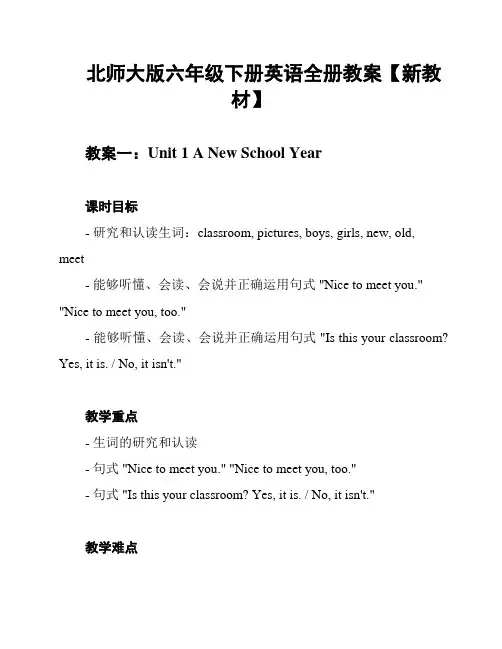
北师大版六年级下册英语全册教案【新教材】教案一:Unit 1 A New School Year课时目标- 研究和认读生词:classroom, pictures, boys, girls, new, old, meet- 能够听懂、会读、会说并正确运用句式 "Nice to meet you." "Nice to meet you, too."- 能够听懂、会读、会说并正确运用句式 "Is this your classroom? Yes, it is. / No, it isn't."教学重点- 生词的研究和认读- 句式 "Nice to meet you." "Nice to meet you, too."- 句式 "Is this your classroom? Yes, it is. / No, it isn't."教学难点- 学生能否正确运用句式 "Nice to meet you." "Nice to meet you, too."- 学生能否正确运用句式 "Is this your classroom? Yes, it is. / No,it isn't."教学准备- PPT- 课件- 生词卡片教学过程1. Warming-up:- 让学生观察教室图片,并复并教授生词 "classroom"。
- 通过问答的方式,巩固学生对于 "new" 和 "old" 的理解。
2. Introduction:- 准备一些小纸片,上面写着学生的名字,并让学生相互认识,并用句式 "Nice to meet you." 进行自我介绍。
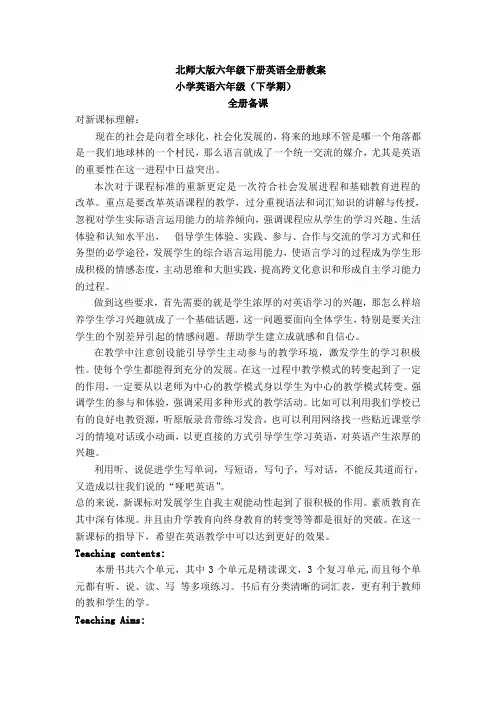
北师大版六年级下册英语全册教案小学英语六年级(下学期)全册备课对新课标理解:现在的社会是向着全球化,社会化发展的,将来的地球不管是哪一个角落都是一我们地球林的一个村民,那么语言就成了一个统一交流的媒介,尤其是英语的重要性在这一进程中日益突出。
本次对于课程标准的重新更定是一次符合社会发展进程和基础教育进程的改革。
重点是要改革英语课程的教学,过分重视语法和词汇知识的讲解与传授,忽视对学生实际语言运用能力的培养倾向,强调课程应从学生的学习兴趣、生活体验和认知水平出,倡导学生体验、实践、参与、合作与交流的学习方式和任务型的必学途径,发展学生的综合语言运用能力,使语言学习的过程成为学生形成积极的情感态度,主动思维和大胆实践,提高跨文化意识和形成自主学习能力的过程。
做到这些要求,首先需要的就是学生浓厚的对英语学习的兴趣,那怎么样培养学生学习兴趣就成了一个基础话题,这一问题要面向全体学生,特别是要关注学生的个别差异引起的情感问题。
帮助学生建立成就感和自信心。
在教学中注意创设能引导学生主动参与的教学环境,激发学生的学习积极性。
使每个学生都能得到充分的发展。
在这一过程中教学模式的转变起到了一定的作用,一定要从以老师为中心的教学模式身以学生为中心的教学模式转变。
强调学生的参与和体验,强调采用多种形式的教学活动。
比如可以利用我们学校已有的良好电教资源,听原版录音带练习发音,也可以利用网络找一些贴近课堂学习的情境对话或小动画,以更直接的方式引导学生学习英语,对英语产生浓厚的兴趣。
利用听、说促进学生写单词,写短语,写句子,写对话,不能反其道而行,又造成以往我们说的“哑吧英语”。
总的来说,新课标对发展学生自我主观能动性起到了很积极的作用。
素质教育在其中深有体现。
并且由升学教育向终身教育的转变等等都是很好的突破。
在这一新课标的指导下,希望在英语教学中可以达到更好的效果。
Teaching contents:本册书共六个单元,其中3个单元是精读课文,3个复习单元,而且每个单元都有听、说、读、写等多项练习。
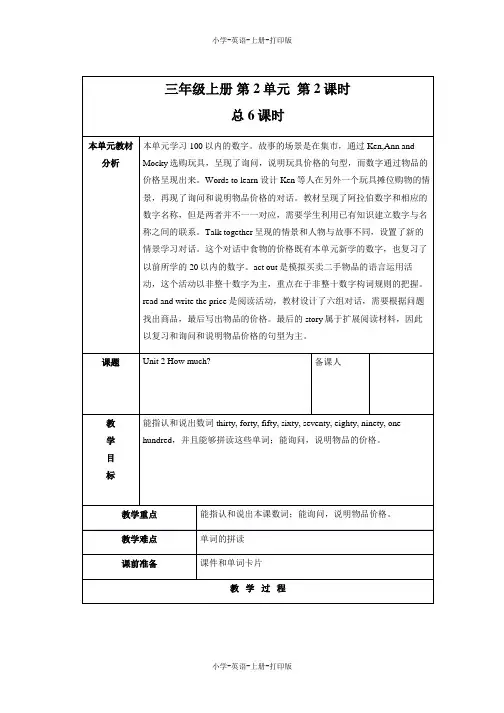
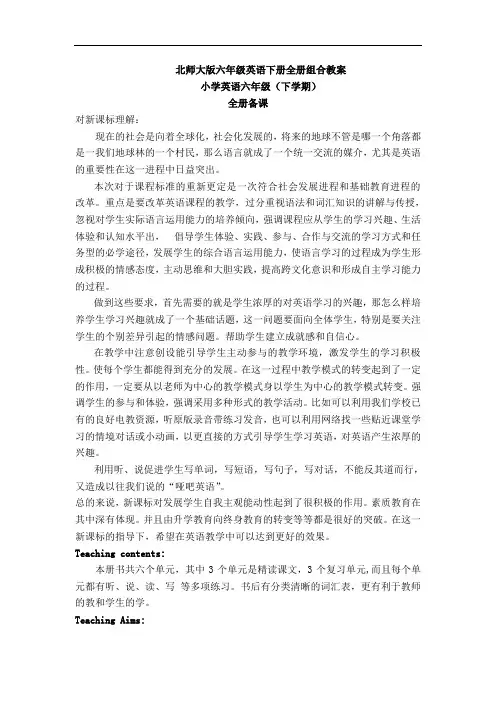
北师大版六年级英语下册全册组合教案小学英语六年级(下学期)全册备课对新课标理解:现在的社会是向着全球化,社会化发展的,将来的地球不管是哪一个角落都是一我们地球林的一个村民,那么语言就成了一个统一交流的媒介,尤其是英语的重要性在这一进程中日益突出。
本次对于课程标准的重新更定是一次符合社会发展进程和基础教育进程的改革。
重点是要改革英语课程的教学,过分重视语法和词汇知识的讲解与传授,忽视对学生实际语言运用能力的培养倾向,强调课程应从学生的学习兴趣、生活体验和认知水平出,倡导学生体验、实践、参与、合作与交流的学习方式和任务型的必学途径,发展学生的综合语言运用能力,使语言学习的过程成为学生形成积极的情感态度,主动思维和大胆实践,提高跨文化意识和形成自主学习能力的过程。
做到这些要求,首先需要的就是学生浓厚的对英语学习的兴趣,那怎么样培养学生学习兴趣就成了一个基础话题,这一问题要面向全体学生,特别是要关注学生的个别差异引起的情感问题。
帮助学生建立成就感和自信心。
在教学中注意创设能引导学生主动参与的教学环境,激发学生的学习积极性。
使每个学生都能得到充分的发展。
在这一过程中教学模式的转变起到了一定的作用,一定要从以老师为中心的教学模式身以学生为中心的教学模式转变。
强调学生的参与和体验,强调采用多种形式的教学活动。
比如可以利用我们学校已有的良好电教资源,听原版录音带练习发音,也可以利用网络找一些贴近课堂学习的情境对话或小动画,以更直接的方式引导学生学习英语,对英语产生浓厚的兴趣。
利用听、说促进学生写单词,写短语,写句子,写对话,不能反其道而行,又造成以往我们说的“哑吧英语”。
总的来说,新课标对发展学生自我主观能动性起到了很积极的作用。
素质教育在其中深有体现。
并且由升学教育向终身教育的转变等等都是很好的突破。
在这一新课标的指导下,希望在英语教学中可以达到更好的效果。
Teaching contents:本册书共六个单元,其中3个单元是精读课文,3个复习单元,而且每个单元都有听、说、读、写等多项练习。
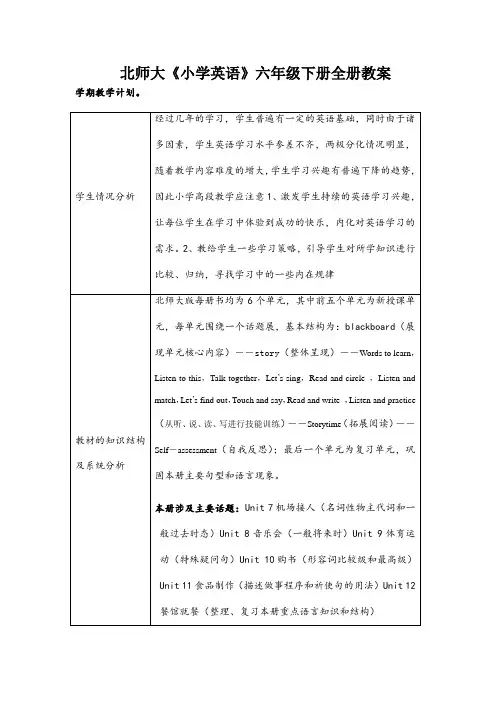
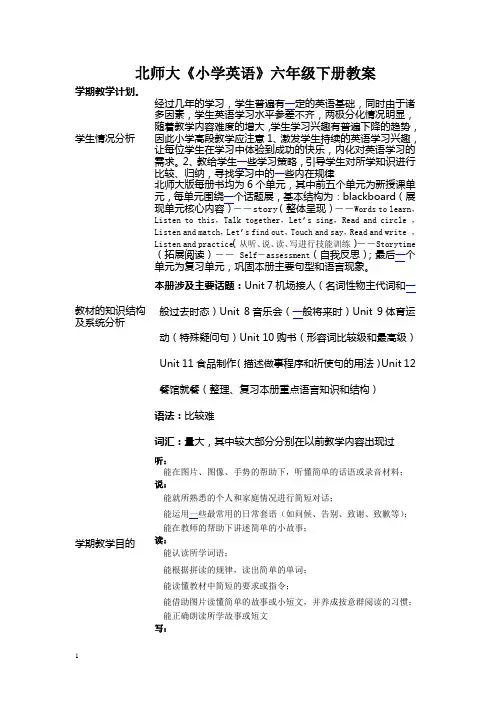
北师大《小学英语》六年级下册教案学期教学计划。
学生情况分析经过几年的学习,学生普遍有一定的英语基础,同时由于诸多因素,学生英语学习水平参差不齐,两极分化情况明显,随着教学内容难度的增大,学生学习兴趣有普遍下降的趋势,因此小学高段教学应注意1、激发学生持续的英语学习兴趣,让每位学生在学习中体验到成功的快乐,内化对英语学习的需求。
2、教给学生一些学习策略,引导学生对所学知识进行比较、归纳,寻找学习中的一些内在规律教材的知识结构及系统分析北师大版每册书均为6个单元,其中前五个单元为新授课单元,每单元围绕一个话题展,基本结构为:blackboard(展现单元核心内容)――story(整体呈现)――Words to learn,Listen to this,Talk together,Let’s sing,Read and circle ,Listen and match,Let’s find out,Touch and say,Read and write ,Listen and practice(从听、说、读、写进行技能训练)――Storytime (拓展阅读)――Self-assessment(自我反思);最后一个单元为复习单元,巩固本册主要句型和语言现象。
本册涉及主要话题:Unit 7机场接人(名词性物主代词和一般过去时态)Unit 8音乐会(一般将来时)Unit 9体育运动(特殊疑问句)Unit 10购书(形容词比较级和最高级)Unit 11食品制作(描述做事程序和祈使句的用法)Unit 12餐馆就餐(整理、复习本册重点语言知识和结构)语法:比较难词汇:量大,其中较大部分分别在以前教学内容出现过学期教学目的听:能在图片、图像、手势的帮助下,听懂简单的话语或录音材料;说:能就所熟悉的个人和家庭情况进行简短对话;能运用一些最常用的日常套语(如问候、告别、致谢、致歉等);能在教师的帮助下讲述简单的小故事;读:能认读所学词语;能根据拼读的规律,读出简单的单词;能读懂教材中简短的要求或指令;能借助图片读懂简单的故事或小短文,并养成按意群阅读的习惯;能正确朗读所学故事或短文写:能模仿范例写句子;能根据要求为图片、实物等写出简短的标题或描述;学期教学重难点1、学习习惯的培养2、学习策略的习得3、各单元故事的理解、认读、复述4、能借助图片读懂简单的故事或小短文,并养成按意群阅读的习惯;5、基本知识和技能语法:名词性物主代词、一般过去时态、一般将来时、特殊疑问句、祈使句、形容词比较级和最高级等的理解、运用词汇:(略)主要的教学措施或教改思路正确把握学情,结合“最近发展区”理论和全语言教学的理念,设定恰当的教学目标,通过创设活动型的课堂,让学生成为课堂的主人,教师成为学生学习的促进者。
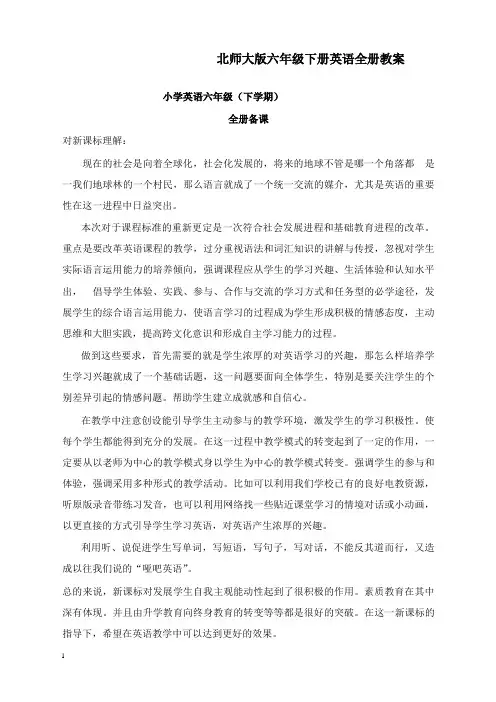
北师大版六年级下册英语全册教案小学英语六年级(下学期)全册备课对新课标理解:现在的社会是向着全球化,社会化发展的,将来的地球不管是哪一个角落都是一我们地球林的一个村民,那么语言就成了一个统一交流的媒介,尤其是英语的重要性在这一进程中日益突出。
本次对于课程标准的重新更定是一次符合社会发展进程和基础教育进程的改革。
重点是要改革英语课程的教学,过分重视语法和词汇知识的讲解与传授,忽视对学生实际语言运用能力的培养倾向,强调课程应从学生的学习兴趣、生活体验和认知水平出,倡导学生体验、实践、参与、合作与交流的学习方式和任务型的必学途径,发展学生的综合语言运用能力,使语言学习的过程成为学生形成积极的情感态度,主动思维和大胆实践,提高跨文化意识和形成自主学习能力的过程。
做到这些要求,首先需要的就是学生浓厚的对英语学习的兴趣,那怎么样培养学生学习兴趣就成了一个基础话题,这一问题要面向全体学生,特别是要关注学生的个别差异引起的情感问题。
帮助学生建立成就感和自信心。
在教学中注意创设能引导学生主动参与的教学环境,激发学生的学习积极性。
使每个学生都能得到充分的发展。
在这一过程中教学模式的转变起到了一定的作用,一定要从以老师为中心的教学模式身以学生为中心的教学模式转变。
强调学生的参与和体验,强调采用多种形式的教学活动。
比如可以利用我们学校已有的良好电教资源,听原版录音带练习发音,也可以利用网络找一些贴近课堂学习的情境对话或小动画,以更直接的方式引导学生学习英语,对英语产生浓厚的兴趣。
利用听、说促进学生写单词,写短语,写句子,写对话,不能反其道而行,又造成以往我们说的“哑吧英语”。
总的来说,新课标对发展学生自我主观能动性起到了很积极的作用。
素质教育在其中深有体现。
并且由升学教育向终身教育的转变等等都是很好的突破。
在这一新课标的指导下,希望在英语教学中可以达到更好的效果。
Teaching contents:本册书共六个单元,其中3个单元是精读课文,3个复习单元,而且每个单元都有听、说、读、写等多项练习。
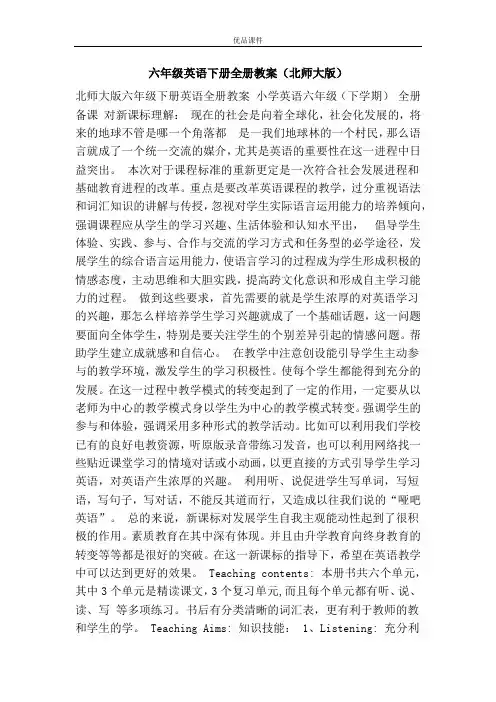
六年级英语下册全册教案(北师大版)北师大版六年级下册英语全册教案小学英语六年级(下学期)全册备课对新课标理解:现在的社会是向着全球化,社会化发展的,将来的地球不管是哪一个角落都是一我们地球林的一个村民,那么语言就成了一个统一交流的媒介,尤其是英语的重要性在这一进程中日益突出。
本次对于课程标准的重新更定是一次符合社会发展进程和基础教育进程的改革。
重点是要改革英语课程的教学,过分重视语法和词汇知识的讲解与传授,忽视对学生实际语言运用能力的培养倾向,强调课程应从学生的学习兴趣、生活体验和认知水平出,倡导学生体验、实践、参与、合作与交流的学习方式和任务型的必学途径,发展学生的综合语言运用能力,使语言学习的过程成为学生形成积极的情感态度,主动思维和大胆实践,提高跨文化意识和形成自主学习能力的过程。
做到这些要求,首先需要的就是学生浓厚的对英语学习的兴趣,那怎么样培养学生学习兴趣就成了一个基础话题,这一问题要面向全体学生,特别是要关注学生的个别差异引起的情感问题。
帮助学生建立成就感和自信心。
在教学中注意创设能引导学生主动参与的教学环境,激发学生的学习积极性。
使每个学生都能得到充分的发展。
在这一过程中教学模式的转变起到了一定的作用,一定要从以老师为中心的教学模式身以学生为中心的教学模式转变。
强调学生的参与和体验,强调采用多种形式的教学活动。
比如可以利用我们学校已有的良好电教资源,听原版录音带练习发音,也可以利用网络找一些贴近课堂学习的情境对话或小动画,以更直接的方式引导学生学习英语,对英语产生浓厚的兴趣。
利用听、说促进学生写单词,写短语,写句子,写对话,不能反其道而行,又造成以往我们说的“哑吧英语”。
总的来说,新课标对发展学生自我主观能动性起到了很积极的作用。
素质教育在其中深有体现。
并且由升学教育向终身教育的转变等等都是很好的突破。
在这一新课标的指导下,希望在英语教学中可以达到更好的效果。
Teaching contents: 本册书共六个单元,其中3个单元是精读课文,3个复习单元,而且每个单元都有听、说、读、写等多项练习。
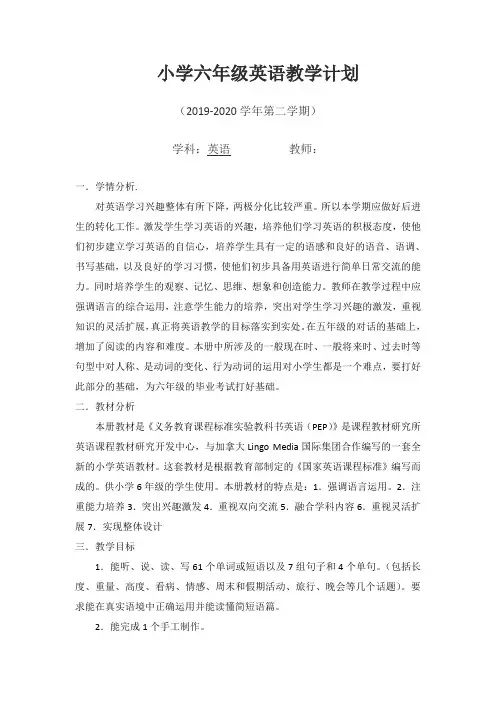
小学六年级英语教学计划(2019-2020学年第二学期)学科:英语教师:一.学情分析.对英语学习兴趣整体有所下降,两极分化比较严重。
所以本学期应做好后进生的转化工作。
激发学生学习英语的兴趣,培养他们学习英语的积极态度,使他们初步建立学习英语的自信心,培养学生具有一定的语感和良好的语音、语调、书写基础,以及良好的学习习惯,使他们初步具备用英语进行简单日常交流的能力。
同时培养学生的观察、记忆、思维、想象和创造能力。
教师在教学过程中应强调语言的综合运用,注意学生能力的培养,突出对学生学习兴趣的激发,重视知识的灵活扩展,真正将英语教学的目标落实到实处。
在五年级的对话的基础上,增加了阅读的内容和难度。
本册中所涉及的一般现在时、一般将来时、过去时等句型中对人称、是动词的变化、行为动词的运用对小学生都是一个难点,要打好此部分的基础,为六年级的毕业考试打好基础。
二.教材分析本册教材是《义务教育课程标准实验教科书英语(PEP)》是课程教材研究所英语课程教材研究开发中心,与加拿大Lingo Media国际集团合作编写的一套全新的小学英语教材。
这套教材是根据教育部制定的《国家英语课程标准》编写而成的。
供小学6年级的学生使用。
本册教材的特点是:1.强调语言运用。
2.注重能力培养3.突出兴趣激发4.重视双向交流5.融合学科内容6.重视灵活扩展7.实现整体设计三.教学目标1.能听、说、读、写61个单词或短语以及7组句子和4个单句。
(包括长度、重量、高度、看病、情感、周末和假期活动、旅行、晚会等几个话题)。
要求能在真实语境中正确运用并能读懂简短语篇。
2.能完成1个手工制作。
3.能听懂、会唱6首歌曲。
4.能听懂、会吟唱6首歌谣。
5.能完成4个自我评价活动。
6.能理解6个幽默小故事。
7.能了解6项简单的中西方文化知识。
四.教材重难点能按四会、三会的要求掌握所学单词。
能按四会要求掌握所学句型。
能使用日常交际用语,活用四会句型,进行简单的交流,做到大胆开口,发音正确。

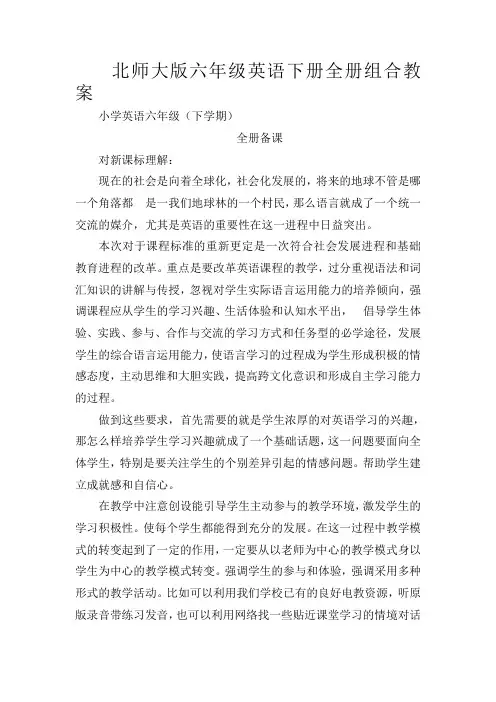
北师大版六年级英语下册全册组合教案小学英语六年级(下学期)全册备课对新课标理解:现在的社会是向着全球化,社会化发展的,将来的地球不管是哪一个角落都是一我们地球林的一个村民,那么语言就成了一个统一交流的媒介,尤其是英语的重要性在这一进程中日益突出。
本次对于课程标准的重新更定是一次符合社会发展进程和基础教育进程的改革。
重点是要改革英语课程的教学,过分重视语法和词汇知识的讲解与传授,忽视对学生实际语言运用能力的培养倾向,强调课程应从学生的学习兴趣、生活体验和认知水平出,倡导学生体验、实践、参与、合作与交流的学习方式和任务型的必学途径,发展学生的综合语言运用能力,使语言学习的过程成为学生形成积极的情感态度,主动思维和大胆实践,提高跨文化意识和形成自主学习能力的过程。
做到这些要求,首先需要的就是学生浓厚的对英语学习的兴趣,那怎么样培养学生学习兴趣就成了一个基础话题,这一问题要面向全体学生,特别是要关注学生的个别差异引起的情感问题。
帮助学生建立成就感和自信心。
在教学中注意创设能引导学生主动参与的教学环境,激发学生的学习积极性。
使每个学生都能得到充分的发展。
在这一过程中教学模式的转变起到了一定的作用,一定要从以老师为中心的教学模式身以学生为中心的教学模式转变。
强调学生的参与和体验,强调采用多种形式的教学活动。
比如可以利用我们学校已有的良好电教资源,听原版录音带练习发音,也可以利用网络找一些贴近课堂学习的情境对话或小动画,以更直接的方式引导学生学习英语,对英语产生浓厚的兴趣。
利用听、说促进学生写单词,写短语,写句子,写对话,不能反其道而行,又造成以往我们说的“哑吧英语”。
总的来说,新课标对发展学生自我主观能动性起到了很积极的作用。
素质教育在其中深有体现。
并且由升学教育向终身教育的转变等等都是很好的突破。
在这一新课标的指导下,希望在英语教学中可以达到更好的效果。
Teaching contents:本册书共六个单元,其中3个单元是精读课文,3个复习单元,而且每个单元都有听、说、读、写等多项练习。
北师大版小学六年级下册英语全册教案北京师范大学《小学英语》五年级下册教案学期教学计划。
学生情况分析经过四年的学习,学生普遍有一定的英语基础,同时由于诸多因素,学生英语学习水平参差不齐,两极分化情况明显,随着教学内容难度的增大,学生学习兴趣有普遍下降的趋势,因此小学高段教学应注意1、激发学生持续的英语学习兴趣,让每位学生在学习中体验到成功的快乐,内化对英语学习的需求。
2、教给学生一些学习策略,引导学生对所学知识进行比较、归纳,寻找学习中的一些内在规律教材的知识结构及系统分析北师大3-11册每册书均为6个单元,其中前五个单元为新授课单元,每单元围绕一个话题展,基本结构为:blackboard(展现单元核心内容)――story(整体呈现)――Words to learn,Listen to this,Talk together,Let’s sing,Read and circle ,Listen and match,Let’s find out,Touch and say,Read and write ,Listen and practice(从听、说、读、写进行技能训练)――Storytime(拓展阅读)―― Self-assessment(自我反思);最后一个单元为复习单元,巩固本册主要句型和语言现象。
本册涉及主要话题:Unit 7机场接人(名词性物主代词和一般过去时态)Unit 8音乐会(一般将来时)Unit 9体育运动(特殊疑问句)Unit 10购书(形容词比较级和最高级)Unit 11食品制作(描述做事程序和祈使句的用法)Unit 12餐馆就餐(整理、复习本册重点语言知识和结构)语法:比较难词汇:量大,其中较大部分分别在以前教学内容出现过学期教学目的听:能在图片、图像、手势的帮助下,听懂简单的话语或录音材料;说:能就所熟悉的个人和家庭情况进行简短对话;能运用一些最常用的日常套语(如问候、告别、致谢、致歉等);能在教师的帮助下讲述简单的小故事;读:能认读所学词语;能根据拼读的规律,读出简单的单词;能读懂教材中简短的要求或指令; 能借助图片读懂简单的故事或小短文,并养成按意群阅读的习惯;能正确朗读所学故事或短文写:能模仿范例写句子;能根据要求为图片、实物等写出简短的标题或描述;学期教学重难点学习习惯的培养学习策略的习得各单元故事的理解、认读、复述能借助图片读懂简单的故事或小短文,并养成按意群阅读的习惯;基本知识和技能语法:名词性物主代词、一般过去时态、一般将来时、特殊疑问句、祈使句、形容词比较级和最高级等的理解、运用词汇:(略)主要的教学措施或教改思路正确把握学情,结合“最近发展区”理论和全语言教学的理念,设定恰当的教学目标,通过创设活动型的课堂,让学生成为课堂的主人,教师成为学生学习的促进者。
六年级第二学期英语教案Unit 1. Where did you buy that hat?⑴教学目标①知识目标:Where did you buy those shoes?I bought them at the shopping mall.How much were they?They were 25yuan.That’s cheep.②能力目标:Asking and giving directions .③情感目标: 鼓舞学生仿照课文的句型进行,现实生或对话。
⑵教学重难点:1. Where did you buy those shoes ?I bought them at the shopping mall.2. How much were they?They were 25 yuan .That’s cheap.⑶教学进程:Lesson 11. Review1)、Put picture cards from SB7 ,Units 5 --7 . : cheap expensive .cheaper more expensive .2)、Braw a big bike and a small bike on the board put price tags on each bike .One is expensive and one is cheap. T: Which is cheaper? Ss : The small bike is cheaper. 3)Continlle asking which is more expensive bigger ect .4)Option draw different objeets if desired.ready1. )TL point to the picture 1: What’s on Gogo’s head? Ss: It’s a hat .2. )Point to picture 2.: Ask Ss to read sentences . silenthy T: Was the hat expensive ? Ss: No, it was n ’s . It was cheap . T: What’s in Gogo’s hand? Ss:They’re sunglasses .3. )Model the answer if necessamythe book.一、) Point to the picture 1:T: Where did Gogo buy his hat?Ss: He bought it at the shopping mall.二、)Look at the picture and listened to the tape3、)Play the tape pausing after each sentence to let Ss repeat.4、)Put Ss into groups to practice the dialogwords:1. ) Put picture cards 1_8 on the board2. ) T: Point to a box of chocolates .A box of chocolates. Ss: A box of chocolates .3. )Continue with the other words .4. )Listen to the tape and repeat .5. )Play the tape and have Ss repeat .6. )Write numbers above each picture card . Have Ss say the words according to the number you say1. )Read the words and text2. )copy the new words at P4Lesson 2.1. Warm –UP1. )Read the words and text .2. )Show the picture on the Bb review the conversation2. Using the book1. )Listen to the tape2. )Write the sentences in Target on Bb . Where did you buy those shoes ? I bought them at the shopping mall . How much were they? They were 25 yuan . That ‘s cheap .3. )分组操练。
北师大版六年级下册英语全册教案小学英语六年级(下学期)全册备课注:其中复习周的课时安排可作为机动课时由任课教师合理安排。
UNIT 7The mountain bike race新课标体现:通过本单元的学习,学生能够运用祈使句语气提出要求,简单说明注意事项。
能够在表达中有意识的使用副词,运用恰当。
通过本单元本短文的学习,学生能够进一步了解某些体育活动的规则和要求。
通过本单元的故事内容,了解自行车越野赛这项运动及其注意事项,培养学生参与体育运动,锻炼身体的习惯,培养学生的安全意识,学会在运动中保护自己。
Teaching Aims:知识技能:1、Listening:能够理解本单元的故事。
2、Speaking:能够在表达中有意识的使用副词,运用恰当。
3、Reading:能正确、流利的朗读课文。
4、Writing:能正确、规范地拼写本单元要求掌握的生词和短语;能听写本单元功能句,并做出应答。
过程方法:1、利用现有的教设备资源,使学生可以更加直观的对所要学习的内容有整体了解,并且可以培养学生良好的发音习惯,为以后的学习打下基础。
2、在教授对话的同时,把单词或重点句型出示给学生,这样可以使学生更方便于学习,掌握,和运用。
3、在教学时多采取同学之间互相帮助的功能,可以加深同学之间的感情,还可以帮助班主任更好的完成思想道德教育工作。
Teaching Emphasis:1.学习情态动词must 的用法。
2.复习情态动词 has to 的用法。
3.形容词变副词的规则变化和不规则变化。
Teaching Difficulty:1.能够理解课文的大意,回答一些关于课文的问题。
2.能够运用祈使句语气提出要求,简单说明注意事项。
能够在表达中有意识的使用副词,运用恰当。
能够进一步了解某些体育活动的规则和要求。
3.一些单词的记忆。
The 1st perTeaching Aims:1. The students can understand the story.2. The students like to learn English.3. The students can be listening and reading.Teaching Emphasis:1.How to understand the story.2.How to read the story.Teaching Difficulty1. How to understand the story and read the story.Teaching process:Step1:ReviewT: Prepare one songs and have the children settle down from their exciting vacation experiences and get ready for the new term. Have the children try to talk about their experiences of winter vacation.S: Try to talk about it.Step2:To review what has been learned last semester.Step3:Set the sceneT: Ask the children if they have ever entered a competition. Ask them the rules of the competition.S: Try to talk about.T: Have the children look at the pictures for the story.S: Look at the pictures.Step4:Pre-story activityT: Have the children look at the pictures and read dialogues on the pages and have the children talk about what they can see in each picture and what they think is happening.S: Try to talk about.T: Play the tape of the story for a few times. Have the children listen to the tape. Ask some questions.S: Listen to the tape and try to answer the questions.(困)Step5:Tell the storyT: Have the children look at the pictures .The teacher tells the story to the children.S: Listen and look at the picture.T: Have the children read the text by themselves.S: Read the text.Step6:Homework: Tell the story to their parents.反思:学生能够理解课文内容,并对课文感兴趣。
北师大版六年级下册英语全册教案小学英语六年级(下学期)对新课标理解:现在的社会是向着全球化,社会化发展的,将来的地球不管是哪一个角落都是一我们地球林的一个村民,那么语言就成了一个统一交流的媒介,尤其是英语的重要性在这一进程中日益突出。
本次对于课程标准的重新更定是一次符合社会发展进程和基础教育进程的改革。
重点是要改革英语课程的教学,过分重视语法和词汇知识的讲解与传授,忽视对学生实际语言运用能力的培养倾向,强调课程应从学生的学习兴趣、生活体验和认知水平出,倡导学生体验、实践、参与、合作与交流的学习方式和任务型的必学途径,发展学生的综合语言运用能力,使语言学习的过程成为学生形成积极的情感态度,主动思维和大胆实践,提高跨文化意识和形成自主学习能力的过程。
做到这些要求,首先需要的就是学生浓厚的对英语学习的兴趣,那怎么样培养学生学习兴趣就成了一个基础话题,这一问题要面向全体学生,特别是要关注学生的个别差异引起的情感问题。
帮助学生建立成就感和自信心。
在教学中注意创设能引导学生主动参与的教学环境,激发学生的学习积极性。
使每个学生都能得到充分的发展。
在这一过程中教学模式的转变起到了一定的作用,一定要从以老师为中心的教学模式身以学生为中心的教学模式转变。
强调学生的参与和体验,强调采用多种形式的教学活动。
比如可以利用我们学校已有的良好电教资源,听原版录音带练习发音,也可以利用网络找一些贴近课堂学习的情境对话或小动画,以更直接的方式引导学生学习英语,对英语产生浓厚的兴趣。
利用听、说促进学生写单词,写短语,写句子,写对话,不能反其道而行,又造成以往我们说的“哑吧英语”。
总的来说,新课标对发展学生自我主观能动性起到了很积极的作用。
素质教育在其中深有体现。
并且由升学教育向终身教育的转变等等都是很好的突破。
在这一新课标的指导下,希望在英语教学中可以达到更好的效果。
Teaching contents:本册书共六个单元,其中3个单元是精读课文,3个复习单元,而且每个单元都有听、说、读、写等多项练习。
北师大版六年级下册英语全册教案小学英语六年级(下学期)对新课标理解:现在的社会是向着全球化,社会化发展的,将来的地球不管是哪一个角落都是一我们地球林的一个村民,那么语言就成了一个统一交流的媒介,尤其是英语的重要性在这一进程中日益突出。
本次对于课程标准的重新更定是一次符合社会发展进程和基础教育进程的改革。
重点是要改革英语课程的教学,过分重视语法和词汇知识的讲解与传授,忽视对学生实际语言运用能力的培养倾向,强调课程应从学生的学习兴趣、生活体验和认知水平出,倡导学生体验、实践、参与、合作与交流的学习方式和任务型的必学途径,发展学生的综合语言运用能力,使语言学习的过程成为学生形成积极的情感态度,主动思维和大胆实践,提高跨文化意识和形成自主学习能力的过程。
做到这些要求,首先需要的就是学生浓厚的对英语学习的兴趣,那怎么样培养学生学习兴趣就成了一个基础话题,这一问题要面向全体学生,特别是要关注学生的个别差异引起的情感问题。
帮助学生建立成就感和自信心。
在教学中注意创设能引导学生主动参与的教学环境,激发学生的学习积极性。
使每个学生都能得到充分的发展。
在这一过程中教学模式的转变起到了一定的作用,一定要从以老师为中心的教学模式身以学生为中心的教学模式转变。
强调学生的参与和体验,强调采用多种形式的教学活动。
比如可以利用我们学校已有的良好电教资源,听原版录音带练习发音,也可以利用网络找一些贴近课堂学习的情境对话或小动画,以更直接的方式引导学生学习英语,对英语产生浓厚的兴趣。
利用听、说促进学生写单词,写短语,写句子,写对话,不能反其道而行,又造成以往我们说的“哑吧英语”。
总的来说,新课标对发展学生自我主观能动性起到了很积极的作用。
素质教育在其中深有体现。
并且由升学教育向终身教育的转变等等都是很好的突破。
在这一新课标的指导下,希望在英语教学中可以达到更好的效果。
Teaching contents:本册书共六个单元,其中3个单元是精读课文,3个复习单元,而且每个单元都有听、说、读、写等多项练习。
书后有分类清晰的词汇表,更有利于教师的教和学生的学。
Teaching Aims:知识技能:1、Listening:充分利用学校的电教资源,在发展学生自主学习的基调上,让学生可以接触到更多的可能更直观的学习方式。
掌握部分常用的日常用语,如:能够运用一般过去时和一般将来时询问一些事情,能够用现在进行时表示将来时来表达一些事情,能够用情态动词表达自己的想法。
2、Speaking:根据册书的教学要求,作为一个主导方向,指导学生在一定的教学情境中,能够正确用过去式讲发生过的事情,用将来时表达将来的事情以及能用进行时表达将来发生的事情。
3、Reading:正确,流利的朗读课文对话及功能操练中的对话,正确读出与课文相关的单词,认读感带有字母组合的单词和一些带有辅音字母的单词。
4、Writing:以听、说、读的基础上,培养学生写的能力。
正确使用英语中的标点符号。
正确对所学句子进行排序。
过程方法:1、发挥老师的指导做用的同时,充分发挥学生的自我主观调动意识,且提高他们自主学习的能力,但要注意教师在教的过程中,对学生思想的指导方向,不能一味的任学生自己发展。
2、充分运用学校已有资源,如:电子媒体进行多方位教学,网络教学等。
这样不但可以提高学生的学习兴趣,又可以丰富学生对新事物的接触机会,从而更直观方便的教和学,在潜移默化中培养学生学习英语的兴趣。
3、在英语的教学过程中,加入适当的对英、美等国家一些风俗习惯在日常生活中的应用。
主要采取同学之间互相帮助的方法,可以形成一帮一小组等方式。
使学生可以在一起分享学习英语给大家带来的乐趣。
鼓励学生多说,多练,尤其注意日常口语在生活中的应用。
情感态度与价值观:1、在英语教学的过程中注意培养学生的学习兴趣是一个老生常谈的问题,因此更应引起我们的重视。
于此教师可以采取多种方式,比如:多采纳、听取学生的意见,抵制学英语给学生带来的负面压力,努力创设一个轻松的学习环境。
2、在英语教学中也应时刻渗透思想道德教育的重要性。
确立良好的价值观和积极向上的人生观,形成同样积极的学习态度。
3、对于申奥成功,无疑是北京对世界张开怀抱的一个机会,学生作为未来世界的主动力,在学习中提倡培养学生的创新意识。
这样才能在竞争如些激烈的社会中立足,做一个社会主义新人。
Teaching Emphasis:1、对于一些日常用语的应用。
2、一些情态动词的用法。
3、一些频度副词的用法。
4、一些词的特殊用法。
5、重点提高学生对单词的掌握。
Teaching Difficulty:1、对日常用语的应用和学生听力的培养。
2、一些情态动词的用法。
3、学生对课文的理解及自己阅读课文的能力。
4、学生对单词的理解和运用。
Teaching planning:注:其中复习周的课时安排可作为机动课时由任课教师合理安排。
UNIT 7The mountain bike race新课标体现:通过本单元的学习,学生能够运用祈使句语气提出要求,简单说明注意事项。
能够在表达中有意识的使用副词,运用恰当。
通过本单元本短文的学习,学生能够进一步了解某些体育活动的规则和要求。
通过本单元的故事内容,了解自行车越野赛这项运动及其注意事项,培养学生参与体育运动,锻炼身体的习惯,培养学生的安全意识,学会在运动中保护自己。
Teaching Aims:知识技能:1、Listening:能够理解本单元的故事。
2、Speaking:能够在表达中有意识的使用副词,运用恰当。
3、Reading:能正确、流利的朗读课文。
4、Writing:能正确、规范地拼写本单元要求掌握的生词和短语;能听写本单元功能句,并做出应答。
过程方法:1、利用现有的教设备资源,使学生可以更加直观的对所要学习的内容有整体了解,并且可以培养学生良好的发音习惯,为以后的学习打下基础。
2、在教授对话的同时,把单词或重点句型出示给学生,这样可以使学生更方便于学习,掌握,和运用。
3、在教学时多采取同学之间互相帮助的功能,可以加深同学之间的感情,还可以帮助班主任更好的完成思想道德教育工作。
Teaching Emphasis:1.学习情态动词must 的用法。
2.复习情态动词 has to 的用法。
3.形容词变副词的规则变化和不规则变化。
Teaching Difficulty:1.能够理解课文的大意,回答一些关于课文的问题。
2.能够运用祈使句语气提出要求,简单说明注意事项。
能够在表达中有意识的使用副词,运用恰当。
能够进一步了解某些体育活动的规则和要求。
3.一些单词的记忆。
The 1st perTeaching Aims:1. The students can understand the story.2. The students like to learn English.3. The students can be listening and reading.Teaching Emphasis:1.How to understand the story.2.How to read the story.Teaching Difficulty1. How to understand the story and read the story.Teaching process:Step1:ReviewT: Prepare one songs and have the children settle down from their exciting vacation experiences and get ready for the new term. Have the children try to talk about their experiences of winter vacation.S: Try to talk about it.Step2:To review what has been learned last semester.Step3:Set the sceneT: Ask the children if they have ever entered a competition. Ask them the rules of the competition.S: Try to talk about.T: Have the children look at the pictures for the story.S: Look at the pictures.Step4:Pre-story activityT: Have the children look at the pictures and read dialogues on the pages and have the children talk about what they can see in each picture and what they think is happening.S: Try to talk about.T: Play the tape of the story for a few times. Have the children listen to the tape. Ask some questions.S: Listen to the tape and try to answer the questions.(困)Step5:Tell the storyT: Have the children look at the pictures .The teacher tells the story to the children.S: Listen and look at the picture.T: Have the children read the text by themselves.S: Read the text.Step6:Homework: Tell the story to their parents.反思:学生能够理解课文内容,并对课文感兴趣。
但课文里生单词较多,有个别单词的读音学生还没有掌握。
The 2nd perTeaching Aims:1. The students can describe the picture.2. The students like to learn English.3. The students can be writing and reading.Teaching Emphasis:1.Learn the new words.2.Try to review the story.Teaching Difficulty1. How to review the story.2. Emphasis new words.Teaching process:Step1:Review :( plays a game)Step2:Learn the new words.T: Have the children open their books at page4. Draw their attention to the top half of the page. Point to the picture and ask: “What can you see in the picture?”S: Open the book and answer the question.T: Model the word and have the children repeat. Use the same procedure with the other words in the picture.S: Read the words after the teacher. (困)T: Let student read the words again.S: read the words.T: Let students listen to the tape and point the new wordsS: listen and point. Repeat after the tape. (困)Step3:Listen to this.T: Have the children look at the pictures at the bottom of the page. Explain that each of the picturesS: Look at the picture.T: Play the tape and have the children match the pictures.S: Listen to the tape and match.T: Play the tape again. Have the children repeat after the tape.S: listen and repeat.Step4:Words you knowT: Point to each drawing and orally elicit the subject name and have the students write.S: Write the words.T: Check the answer by having students volunteer to write the answer on the board.S: Check the answer.Step5:Write the adverbsT: Write the adverbs on the blackboard, have the children read these words. S: Read these words.T: Remind students that we normally add-ly to form an adverb.S: Write them on the books.T: Write some sentences on the blackboard.You’re a good rider. You ride well.He’s a fast rider. He is riding fast.Have the children try to understand these sentences and the adverb. S: Try to understand.Step6:Look and matchT: Have the children look at the sentences and try to match them.S: Try to match.T: Check the answer.Step7:Homework: Read the story.Copy the new words four times.反思:学生基本能掌握做题技巧,能够抓住重点词语。